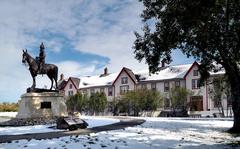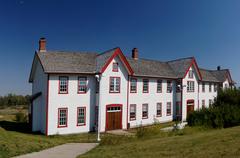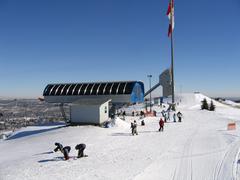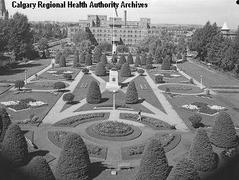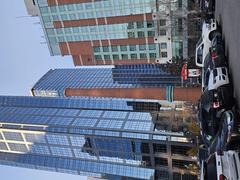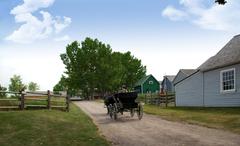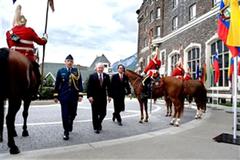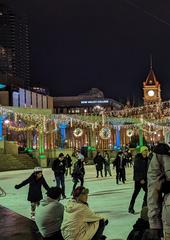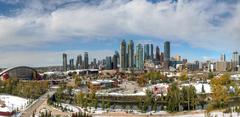
Fort Calgary: Visiting Hours, Tickets, and Historical Significance
Date: 19/07/2024
Introduction
Fort Calgary, a significant historical site, stands as a testament to the birth and evolution of Calgary. Established in 1875 by the North-West Mounted Police (NWMP) at the confluence of the Bow and Elbow Rivers, Fort Calgary’s primary mission was to assert the Canadian government’s authority and curb the illegal whisky trade. Over the years, it evolved into a cornerstone for the development of Western Canada, witnessing crucial events such as the signing of Treaty 7 in 1877 and the arrival of the Canadian Pacific Railway in 1883. The fort’s historical significance extends beyond its physical presence, embodying themes of colonialism, reconciliation, and the enduring legacy of the past. Today, the Fort Calgary Interpretive Centre offers a rich, immersive experience, allowing visitors to delve into the stories of the NWMP officers, Indigenous peoples, and early settlers who shaped the region (Fort Calgary Official Website).
Table of Contents
- History, Significance, Visiting Hours, and Tickets](#history-significance-visiting-hours-and-ticketshistory-significance)
- years)
- Treaty 7 and the Arrival of the Railway](#treaty-7-and-the-arrival-of-the-railwaytreaty-7)
- Calgary’s Rise](#calgarys-risecalgary-rise)
- A Bridge Between Past and Present](#a-bridge-between-past-and-presentfort-today)
- information)
- events)
- spots)
Fort Calgary - History, Significance, Visiting Hours, and Tickets
Fort Calgary’s story is deeply intertwined with the birth and evolution of Calgary itself. What began as a humble wooden fort in 1875, established to assert the Canadian government’s authority and curb the illegal whisky trade, evolved into a pivotal site shaping Western Canada’s future. This article will cover its rich history, significance, and essential visitor information, including Fort Calgary’s visiting hours, ticket prices, and more.
Early Years and the Northwest Mounted Police
The year 1875 marked the arrival of the North-West Mounted Police (NWMP), predecessors of the Royal Canadian Mounted Police (RCMP), at the confluence of the Bow and Elbow Rivers. Their mission was to establish law and order in the vast western territories and pave the way for peaceful settlement. This strategic location, initially named “Fort Briseboine” after NWMP Commissioner James F. Macleod, was soon christened Fort Calgary, taking inspiration from Calgary House on the Isle of Mull, Scotland.
Life at the fort was arduous. The NWMP, facing harsh weather conditions and limited resources, constructed simple wooden structures for shelter, a jail, and stables. Despite the challenges, Fort Calgary became a beacon of order in a region undergoing rapid transformation.
Shaping a Nation - Treaty 7 and the Arrival of the Railway
Fort Calgary played a crucial role in one of the most significant events in Canadian history: the signing of Treaty 7 in 1877. This treaty, signed between the Canadian government and several First Nations, including the Blackfoot Confederacy, the Tsuu T’ina Nation, and the Stoney Nakoda, aimed to ensure peaceful co-existence and open the land for settlement. While the treaty’s legacy remains complex and contested, its signing at Fort Calgary underscores the site’s historical weight.
The arrival of the Canadian Pacific Railway (CPR) in 1883 marked a turning point for Fort Calgary and the entire region. The fort, initially established to control the whisky trade, ironically became a hub for the burgeoning industry. The NWMP found themselves policing a rapidly growing town fueled by railway construction and the influx of settlers.
From Fort to City - Calgary’s Rise
As Calgary boomed, Fort Calgary’s role gradually shifted. The NWMP relocated to a larger barracks in 1914, and the original fort buildings faced demolition. However, a dedicated group of Calgarians, recognizing the site’s historical importance, rallied for its preservation. Their efforts led to the creation of the Fort Calgary Preservation Society in 1978, laying the groundwork for the interpretive center we see today.
Fort Calgary Today - A Bridge Between Past and Present
Today, Fort Calgary stands as a testament to the city’s rich and complex past. The interpretive center, opened in 1978, offers visitors a captivating journey through time, showcasing the fort’s evolution and its impact on the development of Calgary and Western Canada.
The center’s exhibits delve into various aspects of Fort Calgary’s history, including:
- The lives of the NWMP officers and their families: Visitors can explore reconstructed buildings, examine artifacts, and learn about the daily routines and challenges faced by those stationed at the fort.
- The Indigenous perspective: The center acknowledges the Indigenous peoples who have called this land home for centuries, sharing their stories, perspectives, and the lasting impact of colonization.
- The growth of Calgary: Exhibits showcase how the arrival of the railway, the signing of Treaty 7, and the influx of settlers transformed Fort Calgary and its surroundings into the bustling metropolis we know today.
Visitor Information
Visiting Hours
Fort Calgary is open daily from 9 AM to 5 PM. It is closed on major holidays.
Tickets
Tickets can be purchased at the entrance or online. Prices are as follows:
- Adults: $12
- Seniors (65+): $10
- Students (with ID): $10
- Children (6-17): $8
- Children under 6: Free
- Family Pass (2 adults and up to 4 children): $30
Travel Tips
Fort Calgary is easily accessible by public transportation, and there is ample parking available for those driving. Plan to spend at least 2-3 hours to fully explore the site and its exhibits.
Nearby Attractions
While visiting Fort Calgary, consider exploring nearby attractions such as the Calgary Zoo, the Glenbow Museum, and the Calgary Tower.
Accessibility
Fort Calgary is wheelchair accessible, and assistance is available upon request.
Special Events and Tours
Fort Calgary offers a variety of special events and guided tours throughout the year. Check their official website for the latest schedule and to book your spot in advance. Popular events include historical reenactments, educational workshops, and seasonal celebrations.
Photographic Spots
Photography enthusiasts will find plenty of picturesque spots within Fort Calgary. The fort’s reconstructed buildings, scenic river views, and historical artifacts provide excellent backdrops for memorable photos.
Significance of Fort Calgary
Fort Calgary’s significance extends far beyond its physical presence. It serves as a powerful reminder of the complex forces that shaped Western Canada, prompting reflection on themes of colonialism, reconciliation, and the enduring legacy of the past.
- A symbol of Canadian expansion: Fort Calgary represents a pivotal moment in Canadian history, marking the nation’s westward expansion and the assertion of its authority over Indigenous territories.
- A place of reconciliation: The interpretive center acknowledges the injustices faced by Indigenous peoples and strives to foster understanding and respect for their cultures and histories.
- A testament to Calgary’s roots: For Calgarians, Fort Calgary is a tangible link to their city’s origins, offering a glimpse into the lives of those who came before and the events that shaped their community.
Conclusion
Visiting Fort Calgary is not merely a historical excursion; it’s an opportunity to engage with the complex narratives that shaped a nation and a city. It’s a place to reflect on the past, understand the present, and contemplate the future. Whether you’re a history buff, a curious traveler, or a local resident, Fort Calgary offers a rich and engaging experience. Don’t forget to check out the Fort Calgary visiting hours and book your tickets in advance for a seamless visit. For more information on Calgary historical sites and upcoming events, follow our blog and social media channels.
FAQ
What are Fort Calgary’s visiting hours? Fort Calgary is open daily from 9 AM to 5 PM, except on major holidays.
How much do Fort Calgary tickets cost? Ticket prices are as follows: Adults - $12, Seniors (65+) - $10, Students (with ID) - $10, Children (6-17) - $8, Children under 6 - Free, Family Pass (2 adults and up to 4 children) - $30.
Is Fort Calgary accessible for people with disabilities? Yes, Fort Calgary is wheelchair accessible, and assistance is available upon request.


